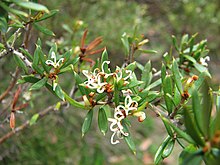Grevillea australis
| Alpine grevillea | |
|---|---|

| |
| Grevillea australis Baw Baw National Park, Victoria | |
| Scientific classification | |
| Kingdom: | Plantae |
| Clade: | Tracheophytes |
| Clade: | Angiosperms |
| Clade: | Eudicots |
| Order: | Proteales |
| Family: | Proteaceae |
| Genus: | Grevillea |
| Species: | G. australis
|
| Binomial name | |
| Grevillea australis R.Br.[1]
| |
| Synonyms[1] | |
|
List
| |
Grevillea australis, commonly known as alpine grevillea[2] or southern grevillea,[3] is a species of flowering plant in the family Proteaceae and is endemic to south-eastern Australia. It is a spreading to prostrate shrub with simple, narrowly egg-shaped leaves and groups of white to pale pink flowers with a glabrous ovary.
Description[]
Grevillea australis is a densely-foliaged, erect to spreading or prostrate shrub that grows to a height of 0.3–1.2 m (1 ft 0 in – 3 ft 11 in). Its leaves are simple, narrowly egg-shaped with the narrower end towards the base or linear, 5–30 mm (0.20–1.18 in) long and 0.5–5.5 mm (0.020–0.217 in) wide with the edges turned down or rolled under. The flowers are arranged in groups near the ends of braches along a rachis 1.0–2.5 mm (0.039–0.098 in) long, and are white or pale pink. The pistil is 6.0–7.5 mm (0.24–0.30 in) long and cream-coloured, the style is hooked near the tip, the ovary stalked and glabrous. Flowering mostly occurs from December to February and the fruit is a glabrous follicle.[2][4][5]
Taxonomy[]
Grevillea australis was first formally described in 1810 by Robert Brown in Transactions of the Linnean Society of London.[6][7] The specific epithet (australis) means "southern".[3]
Distribution and habitat[]
Alpine grevillea grows heath and woodland, usually in moist, rocky places in mountain and alpine areas south from the Brindabella Range in New South Wales to Mount Buller and Mount Baw Baw in Victoria. It is also common in Tasmania, especially on the Central Plateau, and is the only grevillea species in that state.[2][4][8]
Use in horticulture[]
Grevillea australis grows best in cool to cold climates. It grows best in sunny locations in well-drained soil.[3]
References[]
- ^ a b "Grevillea australis". Australian Plant Census. Retrieved 18 December 2021.
- ^ a b c Makinson, Robert O. "Grevillea australis". Royal Botanic Garden Sydney. Retrieved 18 December 2021.
- ^ a b c "Grevillea australis". Australian Native Plants Society. January 2016. Retrieved 22 August 2016.
- ^ a b Makinson, Robert O. "Grevillea australis". Royal Botanic Gardens Victoria. Retrieved 18 December 2021.
- ^ "Grevillea australis". Australian Biological Resources Study, Department of Agriculture, Water and the Environment: Canberra. Retrieved 18 December 2021.
- ^ "Grevillea australis". APNI. Retrieved 18 December 2020.
- ^ Brown, Robert (1810). "On the Proteaceae of Jussieu". Transactions of the Linnean Society of London. 10 (1): 171. Retrieved 18 December 2021.
- ^ Jordan, Greg. "Grevillea australis". University of Tasmania. Retrieved 18 December 2021.
- Grevillea
- Flora of New South Wales
- Flora of Tasmania
- Flora of Victoria (Australia)
- Proteales of Australia
- Plants described in 1810
- Taxa named by Robert Brown (botanist, born 1773)